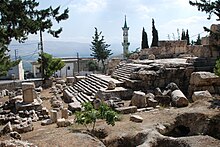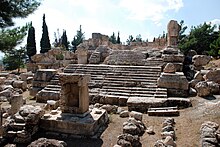Qsarnaba
| Qsarnaba | ||
| State : |
|
|
| Governorate : | Bekaa | |
| District: | Baalbek | |
| Coordinates : | 33 ° 55 ' N , 36 ° 0' E | |
| Height : | 1190 m | |
| Time zone : | UTC + 2 | |
|
|
||
Qsarnaba , also Ksarnaba; is a village on the western edge of the Bekaa plain in Lebanon . In the center of the village are the moderately well-preserved remains of a Roman temple .
location
Qsarnaba belongs to the Baalbek district in Bekaa governorate . The place is located 1190 meters above sea level in a valley on the eastern slope of the Jebel Sannin, the highest point in the southern Lebanon Mountains . The mountain range falls down to the Bekaa plain in round ridges that are separated from each other by serpentine valleys. The villages in the valleys can only be reached from the plain via side roads. At a similar height in the southern neighboring valley is Temnine el-Faouqa , where a Roman spring sanctuary has been preserved, in the Niha valley, which is next but one . There and further up in the same valley in Hosn Niha are temple ruins from Roman times.
The distance from Beirut is 64 kilometers. From Zahlé , a side road that branches off at the village of Ableh leads nine kilometers to the northeast towards Baalbek and a further 2.5 kilometers, gently rising through an area with grapes in the mountains to the town.
Townscape
The municipal area is 6.5 square kilometers. In 2007, the number of permanent residents living in the village was estimated at 2,655. There were 3827 registered voters in the 2004 local elections and 2731 registered voters in the 2016 elections. There are migrant workers who live in the cities but are entitled to vote in their home town. The predominantly Shiite village is controlled by local members of Hezbollah .
The compact center with the mosque is oriented in a circle around the Roman temple. There is one public school, three private schools and two to three small grocery stores. The village grows unplanned with two-story new buildings scattered across the hills below.
Qsarnaba is known for the production of rose water ( ma'wared ). The rose blossoms are picked from mid-April to late May. The flowers are mixed with three times the amount of water in the processing plant. During the distillation, the essence collects as a clear liquid. This rose water, obtained using traditional methods, is used as a flavoring for desserts. Almond , peach, apple and fig trees are also planted in house gardens and in higher elevations on terraced plantations .
Roman temple

Since the middle of the 2nd century the Romans built many small temples and other sanctuaries around the temple area of Heliopolis, today's Baalbek, on the edge of the Bekaa. They were pilgrimage destinations for the inhabitants of the big cities on the coast. One of the Roman processional streets led - partly carved out of the rock - from here directly to the mountain temples of Hosn Niha.
The Prostylos Temple of Qsarnaba with the entrance on the east side stood on a high podium , which was reached via a wide flight of stairs with over 20 steps. The walls of the podium were pulled forward to the east and formed the end of the stairs. The mighty limestone blocks of the former cella wall, which are spread out over the site, are partially weathered to the point of shapelessness. In 1974 the first phase of the restoration was completed, during which up to three rows of the temple walls could be re-erected. In the middle area of the cella, the stepped plinth of an elevated cult square can be seen. A separate sacrificial altar stands outside in the east at the foot of the staircase. In a further restoration phase after 1993, it was assembled from parts and supplemented. The pillars of the vestibule were crowned with Corinthian capitals.
Individual parts of the gable triangle were put together in their original form and placed as a whole next to the temple at ground level. In the upper cornice , a carved relief bust has been preserved at the top of the pediment. It shows the bearded head of a man who presumably represents the founder of the building.
Individual evidence
- ↑ Qsarnaba. Localiban
- ↑ Mawared. ( Memento of the original from April 28, 2010 in the Internet Archive ) Info: The archive link was inserted automatically and has not yet been checked. Please check the original and archive link according to the instructions and then remove this notice. Slow Food Beirut
- ^ Karl-Heinz Bernhardt : The old Lebanon. Verlag Koehler & Amelang, Leipzig 1976, p. 218, map p. 220, figs. 84–86


